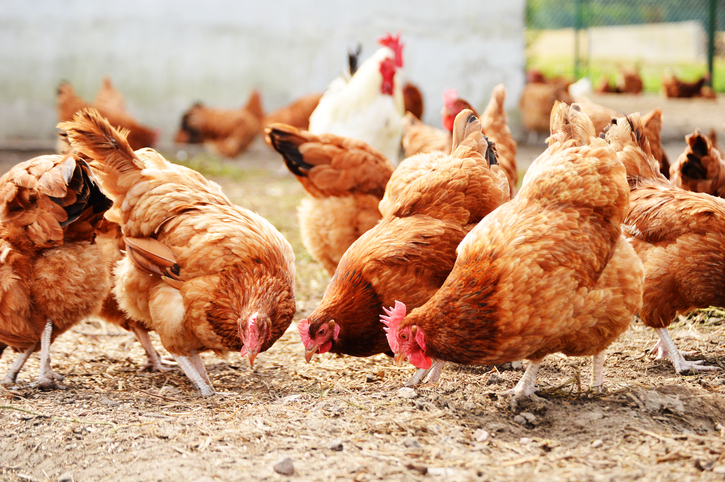When it comes to family dinners, chicken is definitely a crowd-pleaser. Reports say that the average american buys 85 pounds of chicken a year!
And it’s no wonder. This versatile bird can be baked, grilled, broiled or fried into an almost endless variety of delicious dishes. Plus, chicken is a good source of protein and low in fat and calories, especially if you remove the skin and leave it un-breaded.
So let’s say you’ve decided to make chicken tonight for your family and you head out to the grocery store. Here’s where the confusion begins…so many different labels and price points! What does it all mean? Which one is the healthiest?
We weren’t really sure either, so we did the research and we’re here to walk you through all the labeling so you can find safe healthy chicken.
Benefits Of Pastured Raised Organic
Let’s start by talking about what chicken isn’t. Chicken can’t be included in the grass-fed category like cows because chickens are omnivores, not herbivores. Grass-fed labeling doesn’t work when it comes to poultry.
While chickens do eat grass, they also eat a variety of other foraged foods like grubs, worms, seeds, clover and insects. It’s always best for an animal’s health when they stick closest to their natural diet.
When it comes to chickens, “pasture-raised” is the lifestyle leading to optimal health.
In a study conducted at the University of Perugia, Italy, pastured chickens that were allowed to forage and peck outside showed an increase in total antioxidant nutrients and a decrease in the risk of oxidative damage to fat in the meat when compared to conventionally raised or organic, but not pastured, chickens.
If you want the healthiest chicken you can find, certified organic chicken that has been authentically pasture-raised is the way to go. We say “authentically” because the pastured label is misleading, and you may need to do a little extra research to verify.
Why both organic and pasture raised? Organic standards assure you of higher quality feed and other desirable production conditions. Finding chickens that are genuinely pasture-raised assures you of regular daily access to the outdoors with time to forage, roam, and eat naturally. The combination of the two creates the best environment to produce the healthiest chickens.

Here’s the Beenke breakdown of what those confusing chicken labels really mean:
Certified Organic:
Many requirements are placed on chickens labeled certified organic. All feed must be organic, which means it is free from pesticides, chemical fertilizers, animal by-products or other additives (all of these things may be found in conventionally raised chickens). And while organic poultry must meet “free-range” standards, this doesn’t mean they were given sufficient access to the outdoors (see free-range definition below).
Pasture-Raised:
You want to find authentically pastured-raised chickens, meaning birds given ample time outdoors to forage, peck, roam etc. The problem is, the “pasture” label is not regulated as heavily as the certified organic label and therefore isn’t always reliable.
The best way to know for sure is to talk to your butcher, grocer, or farmer and find out how the chickens are actually raised. Two websites that can help find small local farms in your area that are more likely to pasture raise their chickens are:
Free Range:
It’s nice to think about happy chickens roaming the countryside with this label, but this USDA regulated term only means the birds are granted “access” to the outdoors. It doesn’t indicate how big an outdoor area it is, or how long they are allowed out, so the label doesn’t give enough information to be helpful.
Raised without Antibiotics:
This term indicates the chicken was raised without antibiotics for health maintenance, disease prevention, or treatment of disease. Medications that are not classified as antibiotics may still be used.
Antibiotic-Free:
This term cannot be used on labels (but it can be used in marketing). It is a meaningless term. Technically all chicken is antibiotic-free after slaughter as no antibiotic residues are present in the meat due to withdrawal periods required by the government. This doesn’t mean anything to you as a consumer.
No Hormones:
The USDA prohibits the use of hormones in poultry, so this label is meaningless too. All U.S. chickens have no hormones.
Natural:
This label means that no additives or preservatives were introduced after the poultry was processed. It has nothing to do with the standard of care, quality of feed, or administration of medications, therefore it doesn’t really indicate if the meat is healthier or not.
Farm-Raised:
A “farm” is any operation that sells at least $1,000 of agricultural commodities. Any producer that meets this standard can label his chickens farm-raised, but the label says nothing about how the chickens were actually cared for or fed.
Kosher:
Kosher law insists birds be slaughtered with a razor sharp blade using a single cut to the neck. This slaughter practice may be slightly more humane than birds that are stunned in standard operations, but the kosher label doesn’t say anything about the feed or living conditions of the chickens.

Another thing people may wonder about is the difference between light and dark meat. If the chicken you eat is both organic and pasture-raised, there are going to be valuable nutrients in both. If you’re looking to reduce the amount of animal fat in your diet and choose the lowest calorie option, then skinned chicken breast is your best bet with less than 4 grams of fat per serving.
But keep in mind, dark meat does have a little more iron and almost twice the zinc as white meat for only a few grams of fat and about 50 calories more. It may be a good option for your family, at a more wallet-friendly price.
One final note when it comes to chicken, both conventional and organic chicken may be contaminated with potentially problematic bacteria such as Listeria and Salmonella.
The USDA has shown that approximately 1-out-of-8 broiler chicken samples are contaminated with Salmonella.
To avoid exposing your family, it is extremely important to use the utmost care when handling, storing and cooking chicken. Do not let raw chicken come into contact with any food items in your kitchen that you may eat raw (fruits, vegetables, etc.) and be sure to cook chicken up to an internal temperature of 165 degrees F. Cooking your chicken thoroughly will kill any harmful bacteria that may be present in the meat.
Beenke’s Take-Aways:
- Look for certified organic pasture-raised chicken if you can find it.
- Consider doing some extra research to verify the chickens are genuinely “pasture-raised”.
- If you cannot locate pasture raised, choose organic over conventionally raised chickens. This ensures the feed used was organic and free from pesticides, chemicals, etc.
- If you want the leanest cut of chicken, go for skinned chicken breasts. The skin can be removed after cooking.
- Always cook chicken thoroughly. Avoid cross-contamination with any other foods in your kitchen to avoid passing Salmonella or other bacteria to your family.
What do you think about pastured, organic, or conventionally raised chickens? Share your comments in our Health Community!












